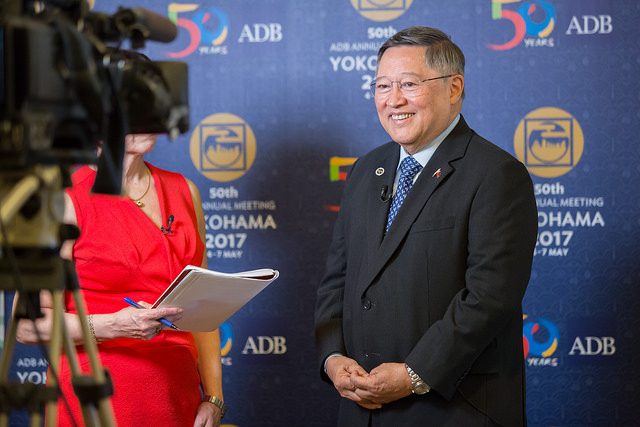SUMMARY
This is AI generated summarization, which may have errors. For context, always refer to the full article.


YOKOHAMA, Japan – Twenty years after the Asian financial crisis, and amid fresh global economic risks, finance ministers and central bank governors of ASEAN, China, Japan, and South Korea (ASEAN+3) agreed to strengthen financial cooperation to increase regional resilience.
ASEAN+3 agreed on the “Yokohama Vision” during their 20th meeting on the sidelines of the 50th ADB Annual Meeting on Friday, May 5. The agreement is meant to serve as guiding principles for a more resilient and integrated ASEAN+3 region.
It also proposed cooperation along two pillars: the enhancement of regional resilience against economic and non-economic shocks, and the promotion of local currency use to support ASEAN financial integration.
“We recognize the importance of further enhancing economic resilience in the region through our collective efforts, in view of our shared responsibility to contribute to sustainable global growth as one of its major drivers,” the group said in a statement.
“Furthermore, we also recognize that increased use of local currencies in cross border transactions will contribute to enhancing regional financial stability over the medium term,” it added.
The meeting, which was co-chaired by Philippine Finance Secretary Carlos Dominguez and Japanese Minister of Finance Taro Aso, also reviewed the progress of past regional cooperation initiatives specifically the Chiang Mai Initiative Mulitlateralization (CMIM), ASEAN+3 Macroeconomic Research Office (AMRO), and the Asian Bond Markets Initiative (ABMI).
The Philippines is this year’s ASEAN chair.
According to the Yokohama Vision document released after the meeting, the region has established these strategies and improvements, which cushioned the region from “adverse impacts in contrast to the rest of the world,” during the 2008 global financial crisis and the 2013 taper tantrum. But it also said it is important to be vigilant against further risks.
To following steps are meant to achieve regional resilience:
- Enhance collaboration between the CMIM and the International Monetary Fund (IMF) to ensure the CMIM is an important part of the global financial safety net
- Clarify the activation process of IMF De-linked Portion of the CMIM and work towards the potential increase of the IMF De-linked Portion
- Enhance AMRO’s capacity and governance
- Promote expansions of bilateral swap arrangement networks
- Establish South East Asia Disaster Risk Insurance Facility to mitigate vulnerability to natural disasters
ASEAN+3 said it would promote local currency use by:
- Diversifying the local currency funding options used available across the region
- Effectively using Credit Guarantee and Investment Facility (CGIF) with expanded guarantee capacity to support the deepening of local currency bond markets
- Sharing successful experiences under ABMI
- Implementing technical assistance and support for human resource development
Also at the meeting were the Asian Development Bank (ADB) president, the AMRO Director, the ASEAN Deputy Secretary General, and the Deputy IMF Managing Director.
ASEAN buffers
ASEAN+3 said in their joint statement that the region is expected to maintain a relatively robust growth and will continue to play a leading role in sustaining global growth, “supported by regional members’ continuing structural reforms and effective implementation of macroeconomic policies.”
“However, risks for the global economy remain skewed to the downside, especially over the medium term, with pervasive uncertainties surrounding policies,” they said.
“The sources of uncertainties include an inward shift in policies, including toward protectionism, and sharper than expected financial tightening,” they added
Asked whether ASEAN was ready for these changes, including the expectation that the US Federal Reserve would raise interest rates this year several more times, Dominguez expressed confidence in the region’s buffers.
“I believe that our economies in ASEAN have experienced very robust financials. Certainly since the Asian crisis 20 years ago, we’ve learned a lot of lessons and improved corporate governance, supervision, and I believe we are better prepared than at any time for external events such as the Federal interest rate increases,” he said.
Dominguez the timing and rate of the increase are “”things we have to watch very carefully and have to double up on our supervision and our watchful waiting so we can handle those external events.”
Bangko Sentral ng Pilipinas Deputy Governor Diwa Guinigundo agreed that enough buffers are in place, including sufficient reserves and encouraging growth dynamics.
“In general, even if the US Fed decides to increase investment rates, not only is the economy strong enough to withstand additional rate hikes, but because of the fiscal policy the new administration is pursuing, I think we have enough buffers to absorb those interest rate shocks,” he said.
Japan support
Earlier on Friday, finance ministers and central bank governors of ASEAN and Japan met and confirmed their commitment to strengthen economic and financial cooperation.
With a goal of sustaining the economic growth of ASEAN and Japan, Japan said it would implement measures along the pillars of enhancing resilience of regional finance; promoting movement of goods and investment in region to support economic integration of ASEAN and Japan; and closing the gap among countries. – Rappler.com
Add a comment
How does this make you feel?





There are no comments yet. Add your comment to start the conversation.